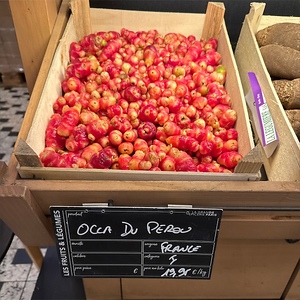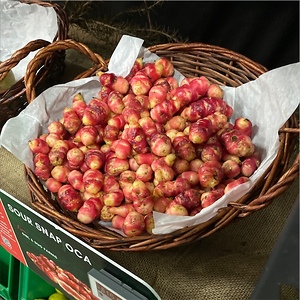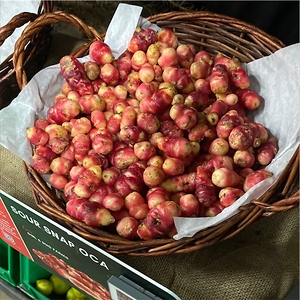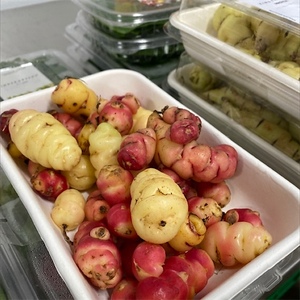


Black Oca
Estimated Inventory, lb : 0
Description/Taste
Black oca is small in size, averaging 5-10 centimeters in length, and is slender, cylindrical in shape with a wrinkled, knobby appearance. The skin transforms from bright red to a dark red-purple, almost black hue when exposed to the sun and has a waxy, shiny surface. The skin is also covered in many medium-set to deep-set eyes which create a bumpy and irregular surface. Underneath the skin, the flesh is moderately firm, semi-starchy, and is pale white to pink along the edges with a darker red center. Black oca is crunchy when raw, and when cooked, it develops a tender, smooth consistency. It also has a mild, earthy taste, similar to the flavor of potatoes, with a hint of tartness.
Seasons/Availability
Black oca is available year-round, with peak seasons in the fall and spring.
Current Facts
Black oca, botanically classified as Oxalis tuberosa, is an edible, underground tuber that grows from a sprawling, leafy plant reaching forty-five centimeters in height and is a member of the Oxalidaceae family. Native to the Andes Mountains of South America, Black oca is a rare, fast-growing, and high-yielding variety that is favored by locals for its unusual red-purple hues, mild flavor, and smooth texture.
Nutritional Value
Black oca is an excellent source of fiber, vitamin C, iron, and phosphorus. It also contains some calcium, zinc, and riboflavin.
Applications
Black oca can be consumed raw in salads or salsas, but it is preferably cooked to create a tender texture and mild flavor. It is also important to note that much of the color will be lost with cooking. Black oca is popularly roasted or boiled for a filling side dish and is often used as a potato substitute in culinary recipes. It can also be sliced and used as a topping on flatbreads, mixed into soups and stews, or sliced and fried to make chips. Black oca pairs well with corn, potatoes, eggplant, peppers, rice, onions, garlic, parmesan cheese, cilantro, and meats such as beef, pork, fish, and poultry. The tubers will keep 2-6 weeks when stored in a paper bag in a cool, dry, and dark place.
Ethnic/Cultural Info
In Peru, there are many different varieties of oca, with new variations being created each year through cultivation. These small tubers are an essential staple in Peruvian cuisine as they are a major source of income, and they are filling, providing a good source of energy. Oca is traditionally boiled or roasted as a side dish in Peruvian cuisine, or it is freeze-dried and ground into a flour for use as a thickener in soups, porridges, and sweets. Oca is also used in the well-known dish Pachamanca, which is a traditional style of cooking tubers, meats, and vegetables in a covered, hot stone earth oven.
Geography/History
Black oca is native to the Andes Mountains of South America and has been growing wild since ancient times. Through extensive cultivation, the tubers were used as an item for trade, allowing for the expansion of the tubers into Mexico in the 1700s. Oca was also introduced to Europe and New Zealand in the mid-1800s. Today Black oca is a rare variety to find outside of local markets in South America, but some tubers can be found for sale through select online retailers for home garden use.
Recipe Ideas
Recipes that include Black Oca. One
| Tin and Thyme |
|
Chili Roasted Oca with Hedgerow Pesto |
| Permaculture UK |
|
Oca Hominy Pie |
| Riverford Organic Farmers |
|
Roasted Oca |











